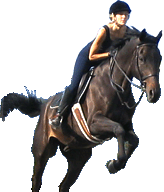|
The general public loves horses, and it shows. Horses are currently
the second most beloved animal. Riding is a noble sport and bonding
with the horse will teach young students confidence, responsibility,
and respect. Overcoming obstacles through communication introduces
you to the effectiveness of body language and the use of the obstacle
course at liberty.
Most people feel that flatwork is a vital part of any type of riding,
it is the basis of anything more advanced than the walk, trot, canter.
There is no substitute for work at the three basic gaits. The skills
developed in flat work straightness, lengthening and shortening,
bending, and turning will also be useful when a rider is ready to
progress to jumping.
Many feel that horseback riding can also help poor posture. Every
rider and horse compensates for one or more parts of the body, but
the basic fundamentals of riding lessons will improve both horse
and rider. Some horses will learn faster than others. A well trained
horse is a horse that is calm, supple, and keen, thus achieving
perfect understanding with its rider.
It is important to remember that horses are unpredictable creatures.
Even well trained horses will often test boundaries and challenge
dominance.
Also keep in mind that horses are fragile animals and that a single
traumatic experience can affect your horse for the rest of their
life. Horses are not stupid and will remember if they are not treated
kindly. Just as you can tell one horse from another, be certain
that horses can tell riders apart as well. Training that encourages
cooperation rather than punishment are generally more effective.
About the Author
Rob Daniels has been an equestrian
rider for 25 years. He has studied various disciplines additional
articles are available at: Riding Stable - http://www.riding-stable.com
and Horse Stall http://www.horse-stall.net |


